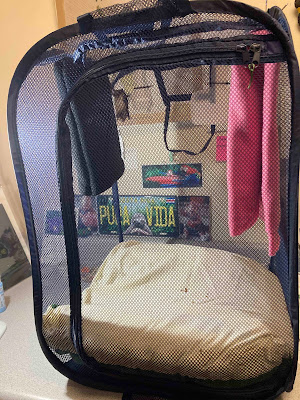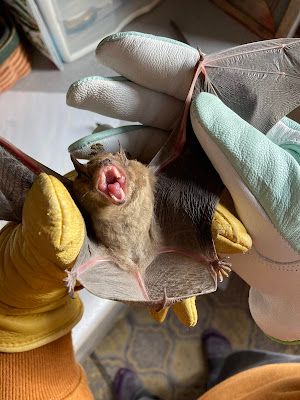Although I've been taking bats in for 13 years, I still consider myself a newcomer to them. There are people who know ever so much more than I do. Amanda Lollar is one of them. She wrote this amazing book which should be required reading for anyone wanting to care for bats. It's so well-written and thorough, informative and clear.

I also follow a couple of great accounts on Instagram: pabatrescue and azbatrescue. I have immense respect for these women and their volunteers. They take in an awful lot of bats, and do vet care as well. Way beyond my level, but they've been kind and encouraging. As a result of what I've learned from this wonderful book and my Instapals, I knew I had to give my bat housing an overhaul. I've ditched the individual critter keepers lined with rubber drawer liner and toweling for a whole new system, one that is more in tune with bat needs for socialization and softness.
Behold the new bat habitats! They're soft nylon laundry hampers that I bought at Wal-Mart. I can access the interior through two large zippered doors.
The flooring is soft mattress foam, wrapped in a plastic garbage bag which is taped tightly, then put in a washable pillowcase. Any bat that falls is not going to be injured in the least.
Each hamper has two places to roost: the made-to-order black bat roosting pouch from
batworld.org (Amanda Lollar's incredible bat conservation organization) and a double folded length of plushy fleece they can crawl up inside. I've got a little plastic water container zip-tied near the top of the enclosure, and a worm dish for self-feeding.
There is one hamper for Carmelo, and one for all the girls. Males must be separated or they will be males, and will molest the females all winter long. These two hampers should be able to accommodate as many bats as I get, boys with boys and girls with girls. There's plenty of room to scuttle around, climb, groom, socialize, and flap wings.
Their first hour in the hamper together, the females gathered under the pink fleece. Jolie Blonde wanted a little separation at first.
Fuchsia, Poppy and Laura cuddled right up. It made me so happy to see the bats able to do what they do in the wild, and to know they were cuddled in warm fleece (I have draped another double layer over the outside of the hamper, too, to protect them from drafts).
By the next morning, there were four in a neat row. Isn't that dear? One is hanging with her dark brown back to us; the rest are showing their paler bellies.
Keeping these bats at the proper temperature (between 35 and 55 degrees) is an interesting exercise. Most of the time, my unheated detached garage is ideal. But when temperatures dip into the 20's, I bring them into my basement and put them right next to a cold door, where temperatures hover in the 40's on a very cold night. I swaddle them to protect them from drafts but it does stay cold by that door.
Ideally, they sleep most of the winter. Initial intake involves getting them up to proper weight (17-22 gm for a big brown) with intensive feeding for each bat for a week or more, and making sure they were strong and well-hydrated. Then I put them to bed in cold temperatures on Jan. 25. I took them out and fed them for the first time on Feb. 9 and 10, after three weeks in cold storage. Now that all are in good weight, I plan to stretch that to 4 or even 6 weeks in hibernation. Not gonna lie--I miss them when they're tucked away! As I update this post, they've been asleep for five weeks. I check on them daily. Temperatures have settled down at night, and the garage maintains nearly ideal conditions. Lovely!
When you think about it, these animals in natural conditions probably have no opportunity to eat and drink all winter long, since they don't fly on nights below 50 degrees. And if they were to fly on the occasional balmy night, there aren't any insects out for them to catch, anyway. So I've little doubt that a winter in Zick's Bat Hostel is a fat winter for these bats. And it sure beats wasting away in a heated space with your metabolism all revved up, but without food or water. Or worse, being caught and put outside to die in freezing temperatures, which is what happens to most bats that are found inside a home. I don't know what people think they're doing when they do that. It's not "letting it go." It's a death sentence for the bat.
I make these posts so people will understand that bats are very much worth cherishing and caring for. When they get into homes, they need help. To find a bat rehabilitator near you, go to
batworld.org and click on "I Found a Bat."
Chances are, it'll be someone a lot like me, who is willing to care for these incredible little animals in their home, because they are endearing and special creatures. Bottom line for me: Yes, it's a ton of work. But the alternative to offering these refugees a safe winter home is too sad to contemplate. If you find a bat in your home, do the right thing and call a bat rehabilitator. Put on leather gloves, pick it up gently with a hand towel around it, and put the bat in a box with the cloth. Make sure the box is SECURELY taped up with a couple small air holes, because bats can get out of the most amazingly tight spaces. Don't try what I'm doing--feeding and watering and handling-- without training and rabies vaccination. These are not pets--they're destined for release. They are going back to the sky!
Carmelo says thank you for the warm fleece and tasty worms.
Laura says thank you very much for listening.


















Sunday, March 12, 2023
5 comments